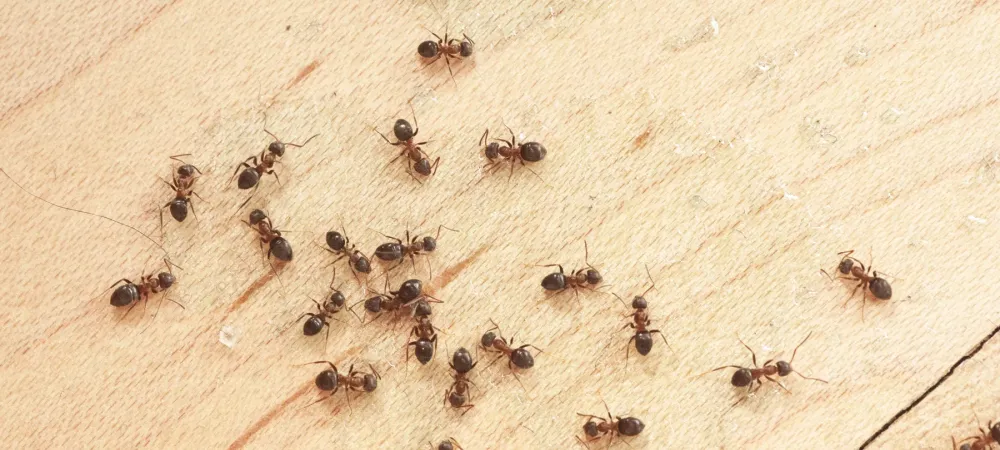Did you know that ants outnumber humans by about a million to one?
They’re everywhere. And if you think we’re immune to problems with ants in the DMV area, you’ve got another thing coming.
The DMV area is home to a wide variety of ant species. From the tiny pavement ants that scurry along sidewalks to the larger carpenter ants that can cause damage to wooden structures, there is no shortage of ant diversity in this region.
Other common species include odorous house ants, Argentine ants, and acrobat ants. Each species has its own unique characteristics and behaviors, making it complicated for the average to know which ant they’re dealing with. Unless you’ve got a magnifying glass and an entomology degree, they kind of all look the same.
That’s why we’ve broken down the most common ant species in the DMV area—so you can tell the difference between an odorous house ant looking for a snack and a carpenter ant silently turning your deck into sawdust.
Characteristics of Ants in the DMV Area
With so many different species of ants in our area, our expert team of ant exterminators has compiled a list of characteristics to look for when deciding what species of ant you’re dealing with.
Odorous House Ants
These pests are incredibly common, and likely win the award for least charming of all ant species.
Odorous house ants are small insects that are typically dark brown or black in color. They are known for their distinctive smell, which is often described as a rotten coconut or a sweet, pungent odor.
These ants are attracted to food and can often be found in kitchens or areas where food is stored. They are also known for their ability to form large colonies, with thousands of ants living together in a single nest. Odorous house ants are not typically aggressive, but they can become a nuisance when they enter homes in search of food.
Argentine Ants
Argentine ants are small but mighty, entering homes with unrivaled appetites and tenacity. They are known for their relentless determination and ability to work together as a team. These ants have a shiny, dark brown or black body, are about 1/8 of an inch long, and have a distinct scent that they use to communicate and recognize each other.
Argentine ants are highly adaptable and can thrive in a variety of environments, from urban areas to natural habitats.
They are voracious eaters and will consume almost anything, including other insects, sweets, and even plant material. They are excellent at foraging and can quickly locate and gather food sources, which is why they sometimes end up inside homes!
Acrobat Ants
Acrobat ants are small, with slender bodies and long legs that allow them to move with agility and grace. Their heads are proportionally larger than their bodies, and they have strong jaws that they use to defend themselves and gather food.
The most distinctive feature of acrobat ants is their ability to raise their abdomen over their head in a curve, resembling an acrobat performing a trick.
Their coloration can vary, but they are typically brown or black with lighter shades on their legs and antennae. With their acrobatic abilities and striking appearance, acrobat ants are truly a fascinating sight to behold.
Carpenter Ants
Of all the ants causing trouble in the DMV, carpenter ants are public enemy number one. These big ants (we’re talking up to ½ inch) prefer to nest in wood, and that includes the beams and posts holding your house together.
Spotting the signs of carpenter ants can be challenging, and requires a bit of detective work. Keep an eye out for random piles of fine sawdust (their calling card), visible trails of ants, or faint rustling sounds behind walls or wooden beams (they’re that loud). Their damage can quickly escalate from cosmetic to structural.
Unlike termites, carpenter ants don’t eat the wood—they chew through it to make their nests. That means the more ants you’ve got, the bigger the network of tunnels weakening your home or outdoor structures.
A few other tips for differentiating carpenter ants from termites:
- Look for a narrow, constricted waist in an ant, along with bent antennae and hind wings shorter than front wings.
- Termites have a more rectangular-shaped body with straight, beaded antennae and four wings of equal size and shape which are much longer than the body.
- Winged termite swarmer’s wings fall off very easily and can be found nearby where they were seen flying or near exit holes from their colonies.
Also, take into account where you spotted them. Ants tend to stay in open areas while winged termites fly around randomly in search of mates until they find suitable habitat for a colony. Then, they rarely come back out again – with the exception of when they swarm during late summer or early autumn months.
Why Do I Have Ants in My Home?
This is one of the most common questions we get as exterminators in the DMV area. Ants, regardless of the species, are tiny creatures with a big impact, and they can’t resist the allure of an easy meal inside of your home.
They are drawn to food crumbs and sweet sugary substances, following their instincts like a compass guiding them to their destination. They will go to great lengths to find a way inside, like a detective on a mission.
How to Prevent Ants in the DMV Area from Coming Inside
Your best line of defense against invading ants in the DMV area is to stop them from getting into your house in the first place. If your home is your castle, your job is to fortify it like the toughest knight in town.
Here are some tips:
Clean Up
Regularly wipe down counters, sweep up crumbs, and never leave dirty dishes out overnight. Ants love messes—they’re practically begging for a seat at your dinner table.
Store Food Properly
Keep food in airtight containers and make trash bins impenetrable. A tightly sealed bin is the ant equivalent of a “closed” sign.
Seal Entry Points
Check window sills, door frames, and any little cracks or crevices. A quick fix with caulk or weather stripping can make a world of difference.
Fix Leaks
Ants are snack-seekers, but all that eating can make them thirsty. Fix drippy faucets and leaky pipes to keep your place dry and uninviting.
Practice Smart Landscaping
Trim back trees and bushes touching your home. These make it easy for ants (and other pests, like termites) to march straight into your house.
Your Go-to-Team for Ant Problems in the DMV
Sometimes, despite your best efforts, you’ll get caught off guard and ants will make their way inside. There’s no need to panic.
First, pinpoint their place of entry. Ants don’t just stroll into your space. Look for trails leading toward doors, windows, or cracks, and lay down barriers to stop them.
Next, break up their flow. Ants leave a scented trail for their buddies. Wipe these trails away with a mix of vinegar and water to throw them off course.
While it might be tempting to just squish the ants you see and call it a day, this can actually be ineffective. Instead, try baiting them. When ants bring the bait back to the colony, it handles the problem right at its source.
And when DIY methods fall short, as they often do, don’t sweat it. That’s what we’re here for.
At Connor’s Pest Control, we know how to make ants regret stepping foot in your home. Whether it’s identifying the species, blocking entry points, or taking care of an invasion with expert precision, we’ve got the solutions you need.
We’re not just here to send the ants packing—we’re here to make sure they never want to return.
If you’re tired of sharing your space with tiny, marching armies, give us a call today. Together, we’ll restore your home to its ant-free glory.



